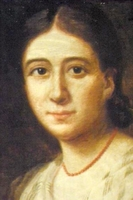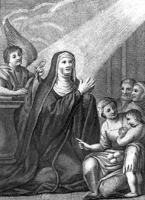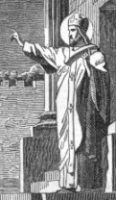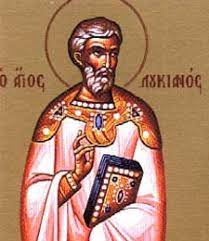Bl. Tommaso Reggio
Feastday: January 9
Birth: 1818
Death: 1901
Beatified: Pope John Paul II
Tommaso Reggio (January 9, 1818 - November 22, 1901) was the Bishop of the Archdiocese of Genoa, Italy. On September 3, 2000, he was beatified by Pope John Paul II.
Tommaso Reggio (9 January 1818 - 22 November 1901) was an Italian Roman Catholic prelate who served as the Archbishop of Genoa from 1892 until his death. He was also the founder of the Sisters of Saint Martha.[1] Reggio distinguished himself during an earthquake that struck his diocese in 1887. He tended to the injured in the rubble and led initiatives to direct diocesan resources towards the displaced and the injured; while in Genoa he collaborated with Bishop Giovanni Battista Scalabrini in tending to immigrants through a range of different pastoral initiatives.[2][3]
Reggio's cause for sainthood opened in 1983 though initiatives had been made prior to this to collect documents in relation to his life and episcopal tenure; he was named as Venerable in 1997 and the miraculous cure of a Chilean girl led to his beatification in Saint Peter's Square on 3 September 2000
St. Foellan
Feastday: January 9
Death: 8th century
Irishman who went with his mother, St. Kentigem, to Scotland, where he became a monk. His other relative was St. Comgan. Foellan died at Strathfillan after missionary activity.
St. Abhor (Amba Hor)
Feastday: January 9
Abhor (or Amba Hor) and Mehraela were a brother and sister who were martyrs for the Christian faith. Etymology of the word "Abhor": from Latin abhorrēre (to shudder at, shrink from), from "ab" (away) and "horrēre" (to bristle, shudder).[1] The book of their "acts" has been lost. Their feast day is celebrated on January 9 in the Coptic Church.
Blessed Pauline-Marie Jaricot
Also known as
Pauline-Marie Jericot
Profile
Born to an aristocratic family. A pious child, at age 17 Pauline adopted a life of extreme asceticism. On 25 December 1816 she made a private vow of perpetual virginity. She organized a group of pious servant girls who prayed to alleviate the sins committed against the Sacred Heart of Jesus; they were known as the Réparatrices du Sacré-Coeur de Jésus-Christ. At Saint-Vallier she worked to bring a number of working girls to a more pious life. These girls and the Réparatrices began collecting pennies from any who would give them, and recruited others to do the same. Collected penny by penny, with the help of bishop Louis Guillaume Valentin Dubourg, Pauline used the money to found the missionary Society of the Propagation of the Faith on 3 May 1822. She founded the Association of the Living Rosary in 1826 which involved a method of distributed praying of the rosary. Pauline received a cure of a heart condition through the intercession of Saint Philomena, developed a strong devotion to her, and spread devotion to her throughout France.
Born
22 July 1799 at Lyon, France
Died
9 January 1862 at Lyon, France of natural causes
Beatified
• 22 May 2022 by Pope Francis
• beatification celebrated in Lyon, France
• the beatification miracle the return to normal neurological function of a small girl after she went into a coma and received brain damage due to lack of oxygen from choking on food
Patronage
poor people; against impoverishment or poverty
Saint Adrian of Canterbury
காண்டர்பரி நகர் புனிதர் அட்ரியான்
பிரபல அறிஞர்/ மடாதிபதி:
ஏற்கும் சமயம்:
கத்தோலிக்க திருச்சபை
பிறப்பு: தெரியவில்லை
இறப்பு: கி.பி. 710
நினைவுத் திருநாள்: ஜனவரி 9
கிறிஸ்தவ புனிதரான அட்ரியான், ஒரு புகழ்பெற்ற அறிஞரும், தென்கிழக்கு இங்கிலாந்தின் "கென்ட்" (Kent) பிராந்தியத்தின் "காண்டர்பரி" (Canterbury) என்ற இடத்திலுள்ள "புனித அகுஸ்தினார் துறவு மடத்தின்" (St Augustine's Abbey) மடாதிபதியுமாவார்.
வாழ்க்கை:
துறவியும், திருச்சபையின் மறைவல்லுனருமான, புனிதர் “பீட்” (Bede) என்பவரின் எழுத்துக்களின்படி, இவர் வட ஆப்பிரிக்காவின் (North Africa) “பெர்பெர்” (Berber) எனும் பழங்குடி இனத்தைச் சேர்ந்தவர் ஆவார். நேப்பிள்ஸ் (Naples) அருகேயுள்ள "மொனாஸ்டெரியம் நிரிடனும்" (Monasterium Niridanum) எனும் துறவு மடத்தின் மடாதிபதியாகவும் இருந்தவர் ஆவார். திருத்தந்தை “விட்டாலியன்” (Pope Vitalian) இவருக்கு இரண்டு முறை "காண்டர்பரி" (Canterbury) மறை மாவட்டத்தின் பேராயர் பொறுப்பு அளித்தார். ஆனால் அதனை அவர் தாழ்ச்சியுடன் மறுத்து விட்டார். முதலில், அவர் அருகாமையிலுள்ள துறவு மடத்தைச் சேர்ந்த ஆண்ட்ரூ (Andrew) என்னும் துறவிக்கு பரிந்துரைத்தார். அவரும் அதனை தமது தள்ளாத வயதைக் காரணம் காட்டி மறுத்து விட்டார். இரண்டாவது முறையாக பேராயர் பொறுப்பு அவருக்கு திருத்தந்தை விட்டாலியனால் கொடுக்கப்பட்ட போது, அவர் அதனை தமது நண்பரான "தியோடர்" (Theodore of Tarsus) என்பவருக்காக பரிந்துரைத்தார். எதேச்சையாக அவரும் ரோமில் இருந்ததாலும், அவர் பேராயர் பொறுப்பினை ஏற்றுக்கொள்ள சம்மதித்ததாலும் அவருக்கே அப்பொறுப்பு கொடுக்கப்பட்டது. இருப்பினும், அட்ரியான் ஏற்கனவே இரண்டு முறை "கௌல்" (Gaul) எனும் இடத்திற்கு பயணம் மேற்கொண்டிருந்த அனுபவம் இருந்ததாலும், அவரே புதிய பேராயருடன் பிரிட்டன் செல்ல வேண்டுமென திருத்தந்தை விட்டாலியன் அவர்கள் நிர்ணயித்தார்கள்.
கி.பி. 668ம் ஆண்டு, மே மாதம், 27ம் நாள், ஆரம்பித்த அவர்களது இங்கிலாந்து நோக்கிய பயணம் சரியாக ஒரு வருடம் கழித்து 669ம் ஆண்டு, மே மாதம் நிறைவுற்றது. கடல்வழி பயணம் மேற்கொண்ட அவர்கள் "மார்செய்ல்" (Marseille) நாட்டைக் கடந்து "ஆர்ல்ஸ்" (Arles) நாடு போய் சேர்ந்தனர். கௌல் மாநிலத்தை ஆண்ட அப்போதைய இளம் அரசன் "மூன்றாம் க்லோடேயர்" (Clotaire III) என்பவரின் கீழுள்ள அரசு ஆளுநரிடமிருந்து கடவுச்சீட்டு (Passports) பெறுவதற்காக அங்கே அவர்கள் பேராயர் ஜான் என்பவருடன் தங்கினார்கள். பின்னர் அங்கிருந்து அவர்கள் வட ஃபிரான்ஸ் நோக்கி பயணித்தனர். குளிர் காலத்தில் தங்குவதற்காக அவர்கள் இரு குழுக்களாக பிரிந்து பயணித்தனர். தியோடோர் பாரிஸ் ஆயர் அகேல்பெர்க்டஸ்" (Agelberctus) என்பவருடனும் அட்ரியான் 'சென்ஸ் ஆயர் எம்மோன்" (Emmon, Bishop of Sens) என்பவருடனும் பயணித்தனர். இங்கிலாந்து சென்றடைந்ததும் அட்ரியான் உடனடியாக "புனித பீட்டர் துறவு மடத்தின்" (St. Peter Abbey) மடாதிபதியாக பொறுப்பேற்றார். இம்மடம்தான் பின்னாளில் "புனித அகுஸ்தினார் துறவு மடம்" (St. Augustine's Abbey) என்று அழைக்கப்பட்டது.
புனிதர் "பீட்" (Bede) அட்ரியானைப் பற்றி பின்வருமாறு எழுதுகிறார்:
அட்ரியான் கிரேக்கம் மற்றும் இலத்தின் போன்ற பன்மொழிகளில் விவிலியத்தைக் கற்று புலமை பெற்றிருந்தார். இவர் ஒரு வெற்றிகரமான நிர்வாகியும் ஆவார். அவரது வழிகாட்டுதலின் கீழே அவரது துறவு மடம் கணிசமாக செல்வாக்கு பெற்றது. அட்ரியான் ஒரு புகழ்பெற்ற இறையியலாளர் மட்டுமல்லாது மதச் சார்பற்ற கற்றலை கூடியவரை நிறைவேற்றினார். தீவின் அனைத்து பகுதிகளிலும் பயணித்து பலதரப்பட்ட அறிஞர்களை ஒன்று கூட்டினார்கள். தம்மைத் தாமே பணிகளில் ஈடுபடுத்திக்கொண்டார்கள். விடாமுயற்சியுடன் அவர்கள் செய்த சேவைகள், கிறிஸ்தவ மதம் சம்பந்தமானதாக மட்டுமல்லாது சீருக்குரிய கலை, வானியல், எண்கணிதம், சொல்லாட்சி, உயிரியல், கணிதம் மற்றும் இலத்தீன், கிரேக்கம் ஆகிய மொழிகளையும் கற்பித்தனர். அட்ரியான் மற்றும் தியோடர் ஆகியோரின் மாணவர்களாக தேர்ந்துகொள்ளப்பட்டவர்கள் பேசிய கிரேக்கம் மற்றும் இலத்தீன் ஆகிய மொழிகள் அவர்களது தாய் மொழியைப் போலவே இருந்தன.
இங்கிலாந்து, கல்வியால் மலர்ச்சியடையும் நாடாக இவர்களால் அறிமுகப்படுத்தப்பட்டது. ஒன்பதாம் நூற்றாண்டின் இறுதியில், திருத்தந்தை முதலாம் கிரகோரியின் (Pope Gregory I) மொழிமாற்ற ("Liber Pastoralis Curae") நூலின் முன்னுரையில் அரசர் “அல்ஃபிரெட்" (King Alfred) இதனைக் குறிப்பிடுகின்றார்.
ஜனவரி ஒன்பதாம் தேதி மரணமடைந்த அட்ரியான், அவரது துறவு மடத்தின் ஆலயத்தில் அடக்கம் செய்யப்பட்டார்.
Also known as
Adrien, Hadrian
Profile
In the mid 640's, his family fled to Naples, Italy ahead of Arab invasion. Benedictine monk when quite young. Abbot of Hiridanum, Isle of Nisida, Bay of Naples. Aquainted with Emperor Constans II, who later introduced him to Pope Saint Vitalian. Advisor to Vitalian.
Twice offered the Archbishopric of Canterbury, England; he declined, citing unworthiness. When Saint Theodore of Tarsus was sent instead, Adrian went as his assistant with special support to aid the monastic movement in the region. Detained in France due to suspicions of espionage for the emperor. Arrived in England in 669. Abbot of Saint Peter's, a monastery founded by Augustine of Canterbury.
Adrian and Theodore were highly successful missionaries in largely pagan England. In addition, Adrian was a great teacher of languages, mathematics, poetry, astronomy, and Bible study. Under his leadership, the School of Canterbury became the center of English learning. Worked to unify the customs of the English with the Church, and to promote Roman customs.
Born
c.635 in Libya Cyrenaica, North Africa as Hadrian
Died
• 9 January 710 of natural causes at Canterbury, England, and buried there
• his tomb became a site of miracles
• body found incorrupt in 1091
Blessed Alix le Clerc
Also known as
• Alix of Mattaincourt
• Alix Le Clercq
• Alice le Clerc
• Alessia le Clerc
• Maria Teresa of Jesus
• Marie-Thérèse of Jesus
Profile
Born to a wealthy family, Alix grew up loving dance and music and parties and was known as a silly and frivolous girl. At age 21, however, she had a conversion experience, and became a spiritual student of Saint Peter Fourier. She was devoted to the education of girls, and in 1598 co-founded the Congregation of Our Lady, Canonesses of Saint Augustine to teach poor children; at one point the Congregation had 60 houses, survived the excesses of the French Revolution, and today runs schools in ten countries in Europe and South America.
Born
2 February 1576 in Remiremont, Vosges, France
Died
• 9 January 1622 in the Congregation convent at Nancy, Meurthe-et-Moselle, France of natural causes
• buried in the convent cemetery in a lead coffin, but site of the grave was lost when the convent was destroyed during the French Revolution
• coffin re-discovered in 1950
• relics enshrined in the chapel of the Notre Dame School in Nancy, France in 1960
• relics enshrined in a chapel in the cathedral of Nancy on 14 October 2007
Beatified
4 May 1947 by Pope Pius XII
Black Nazarene
Also known as
Nuestro Padre Jesús Nazareno
Profile
The Black Nazarene is a blackened, life-sized wooden icon of Jesus Christ carrying a cross. It was constructed in Mexico in the early 17th century by an Aztec carpenter. Spanish Augustinian Recollect friar missionaries to Manila, Philippines originally brought the icon to Manila in 1606. The transport ship caught fire, burning the icon, but the locals kept the charred statue. Miracles, especially healings, have been reported in its presence. The church in which it stood burned down around it in 1791 and 1929, was destroyed by earthquakes in 1645 and 1863, and was damaged during bombing in 1945. It used to be carried through the streets every January, and Christians would rub cloths on it to make healing relics, but centuries of this treatment have left the statue in bad shape, and since 1998 a replica is paraded at the feast day celebrations. In 1650, Pope Innocent X issued a papal bull which canonically established the Cofradia de Jesús Nazareno to encourage devotion; in the 19th century Pope Pius VII granted indulgences to those who piously pray before the image.
Patronage
Quiapo, Philippines
Saint Waningus of Fécamp
Also known as
• Waningus of Ham
• Vaneng, Waneng, Wanging, Waning, Wanning
Additional Memorials
• 31 January (Normandy, France)
• 15 February (Rouen, France)
• 23 September (translation of relics)
Profile
Frankish nobleman, living a worldly and dissolute life in the court of King Clotaire III of Neustria. Father of Saint Desiderius of Fontenelle. One night he had a dream in which Saint Eulalia of Barcelona, to whom he had a devotion, told him of the difficulties the rich had entering Heaven. He gave up the life of a courtier to become a Benedictine monk. Abbot. Assisted Saint Wandrille in founding Fontenelle abbey. Responsible for establishing Holy Trinity Church and Convent at Fécamp, France. Sheltered Saint Leodegarius when he was on the run from Ebroin.
Born
Rouen, France
Died
• c.688 of natural causes
• relics transferred to Ham, Picardy (in modern France) to save them from invading pagan Normans
• some relics transferred to Hallon, France on 23 September 1696
Blessed Józef Pawlowski
Also known as
Joseph Pawlowski
Additional Memorial
12 June as one of the 108 Martyrs of World War II
Profile
Priest in the diocese of Kielce, Poland, and rector of its seminary. Arrested by the Gestapo on 10 February 1941 and deported to the Dachau concentration camp as part of the Nazi persecution of Christians. Martyr.
Born
12 August 1890 in Proszowice, Swietokrzyskie, Poland
Died
hanged on 9 January 1942 in the prison camp at Dachau, Oberbayern, Germany
Beatified
13 June 1999 by Pope John Paul II
Blessed Julia of Certaldo
Also known as
• Giulia della Rena da Certaldo
• Julia della Rena
Profile
Born to an impoverished noble family. Worked as a domestic servant in her youth in the Timolfi household at Florence, Italy. She became an Augustinian tertiary at age 19. Florence was in turmoil in those years, and Julia returned to the quiet of Certaldo, Tuscany. There she rescued a child from a burning building, which brought her unwanted fame. She retired to lived nearly 30 years as an anchoress in a cell built onto the church of Saint Michael and Saint James at Certaldo.
Born
1319 at Certaldo, Italy
Died
9 January 1367 of natural causes
Beatified
1819 by Pope Pius VII (cultus confirmed)
Representation
• woman wearing a black habit and white veil, and rescuing a child from a burning bed
• woman giving flowers to children in winter
• woman rescuing a drowning horseman
Blessed Kazimierz Grelewski
Also known as
Casimiro Grelewski
Additional Memorial
12 June as one of the 108 Martyrs of World War II
Profile
Brother of Blessed Stefan Grelewski. Parish priest, teacher and prefect of schools in the diocese of Radom, Poland. Arrested by the Gestapo on 24 January 1941 and deported to the Dachau concentration camp as part of the Nazi persecution of Christians. He was murdered by a guard who was angry because Father Kazimierz would not stop forgiving those who beat him. Martyr.
Born
20 January 1907 in Dwikozy, Swietokrzyskie, Poland
Died
hanged on 9 January 1942 in the prison camp at Dachau, Oberbayern, Germany
Beatified
13 June 1999 by Pope John Paul II
Readings
Love God! - Blessed Kazimierz last words, shouted from the gallows to the people who were hanging him
Saint Honorius of Buzançais
Also known as
• Honorius of Buzançay
• Honorius of Thénezay
• Honoratus, Honore, Onorato
Profile
Wealthy layman cattle merchant noted for his love of life and his charity. When he returned from a trip, he found his servants had robbed him. As he was explaining the sinfulness of this action, they killed him. Because he was killed while reproving sinners for their crimes, he is considered a martyr. Never considered a saint in life, there were many miracles associated with his tomb, and a popular devotion soon developed.
Born
at Buzançais, Berry, France
Died
murdered in 1250 at Parthenay, Poitou, France
Canonized
1444 by Pope Eugene IV (cultus confirmed)
Saint Brithwald of Canterbury
Also known as
Beorhtweald, Berctuald, Bercthwald, Beretuald, Berhtwald, Berthwald, Bertwald, Brihtwald
Profile
Educated at Canterbury, England. Benedictine monk and then abbot of Reculver Abbey, Kent, England. Abbot of Glastonbury Abbey. Archbishop of Canterbury from 692 until his death nearly 40 years later. Correspondent of with Saint Boniface, Saint Aldhelm, and Saint Wilfrid of York. Assisted at the Synod of Nidd.
Born
Anglo-Saxon
Died
• 731 of natural causes
• Saint Augustine's abbey, Canterbury, England
Saint Marciana
Profile
Young Christian girl who was beaten, tortured and handed over to gladiators as a sex toy during the persecutions of Diocletian; she brought one of the gladiators to Christianity. Accused of vandalizing an idol of the goddess Diana, she was thrown to wild animals in the arena. Martyr.
Born
Rusuccuru, Mauritania
Died
gored by a bull and mauled by a leopard in the amphitheater of Caesarea, Mauritania c.303
Patronage
cure of wounds
Representation
• woman gored by a bull
• woman carrying a palm of martyrdom while a leopard and bull stand nearby
Saint Marcellinus of Ancona
Also known as
Marcellin, Marcellino
Profile
Born to the nobility. Bishop of Ancona, Italy c.550. Mentioned in the writings of Saint Gregory the Great.
Born
in Ancona, Italy
Died
c.566 of natural causes
Patronage
against fire (he stopped a raging fire by waving his prayer book at it; the book survived a fire with only slight damage; afterwards, people who held it while praying were often healed)
Saint Teresa Kim
Also known as
• Theresia Kim
• Teresa Gim
Additional Memorial
20 September as one of the Martyrs of Korea
Profile
Married lay women in the apostolic vicariate of Korea. Widow. Imprisoned, beaten, tortured and executed for being a Christian. Martyr.
Born
1797 in Myeoncheon, Chungcheong-do, South Korea
Died
9 January 1840 in Seoul Prison, South Korea
Canonized
6 May 1984 by Pope John Paul II
Blessed Richard of Floreffe
Profile
One of the first Premonstratensian canons, joining at the Prémontré monastery at Laon, Aisne, Picardy, France in 1120. First prior of the monastery at Floreffe, Vallonia (in modern Belgium) in 1122 where he served the rest of his life. Richard was a pious man, known for his charity to the poor and his love of spreading the faith.
Born
latter 11th century France
Died
1129 of natural causes
Blessed Eberhard of Schäftlarn
Profile
Premonstratensian canon. Prior of the Premonstratensian monastery in Schäftlarn, Bavaria (in modern Germany) in 1153. He was known as a humble and modest man who took generous care of his fellow canons and the faithful pilgrims who passed through the city.
Born
c.1100 in Germany
Died
9 January 1160 in Schäftlarn, Bavaria, Germany of natural causes
Blessed Antony Fatati
Also known as
• Anthony of Teramo
• Anthony of Ancona
• Antoine...
Profile
Priest. Archpriest of Ancona, Italy. Vicar-general of Siena, Italy. Canon of the Vatican in Rome, Italy. Bishop of Teramo, Italy. Bishop of Ancona.
Born
c.1410 in Ancona, Italy
Died
9 January 1484 of natural causes
Beatified
by Pope Pius VI (cultus confirmed)
Blessed Franciscus Yi Bo-hyeon
Also known as
Francis
Additional Memorial
20 September as one of the Martyrs of Korea
Profile
Layman martyr in the apostolic vicariate of Korea.
Born
1773 in Deoksan, Chungcheong-do, South Korea
Died
9 January 1800 in Haemi, Chungcheong-do, South Korea
Beatified
15 August 2014 by Pope Francis
Blessed Martinus In Eon-min
Also known as
Martin
Additional Memorial
20 September as one of the Martyrs of Korea
Profile
Layman martyr in the apostolic vicariate of Korea.
Born
1737 in Deoksan, Chungcheong-do, South Korea
Died
9 January 1800 in Haemi, Chungcheong-do, South Korea
Beatified
15 August 2014 by Pope Francis
Saint Agatha Yi
Additional Memorial
20 September as one of the Martyrs of Korea
Profile
Young single lay woman martyred in the persecutions in Korea.
Born
1824 in Seoul, South Korea
Died
9 January 1840 in Seoul Prison, South Korea
Canonized
6 May 1984 by Pope John Paul II
Saint Ephrathus the Thaumaturgist
Also known as
• Ephrathus the Wonder Worker
• Ephrathus of Mount Olympus
• Ephrathus of Abgaro
Profile
Monk. Abbot of the Abgaro monastery on Mount Olympus, Bithynia (in modern Turkey).
Died
9th century
Saint Paschasia of Dijon
Also known as
Paschasie
Profile
Consecrated virgin (an early type of nun). Spiritual student of Saint Benigne and and helped in his missionary work. Martyr. Saint Gregory of Tours mentions her.
Died
c.178 in the area of modern Dijon, France
Saint Maurontus
Also known as
Maurentius, Maurontius, Mauruntius, Mavrontus
Profile
Benedictine monk. Abbot. Founder of Saint-Florentle-Vieil abbey, Anjou, France.
Died
c.695 at St-Florent-le-Vieil, Angers, France of natural causes
Saint Polyeucte
Profile
Pagan soldier in the 12th imperial Roman legion assigned to Armenia in the 3rd century. Friend of Saint Nearchus who brought him to the faith. Ordered to offer a sacrifice of incense to the emperor as a god, Polyeucte refused. Martyr.
Saint Nearchus
Profile
Christian soldier in the 12th imperial Roman legion assigned to Armenia in the 3rd century. Friend of Saint Polyeucte. Ordered to offer a sacrifice of incense to the emperor as a god, Nearchus refused. Martyr.
Saint Philip Berruyer
Also known as
Philip of Bourges
Profile
Nephew of Saint William of Bourges. Archbishop of Bourges, France.
Died
1260 of natural causes
Saint Felanus of Saint Andrew
Profile
Hermit. Monk. Abbot of the monastery of Saint Andrew in Scotland.
Died
c.710 in Scotland of natural causes
Saint Eustratius of Olympus
Also known as
Eustrate, Eustrazio
Profile
Abbot of the Abgar Abby on Mount Olympus in Bithynia (modern Turkey).
Saint Fortunatus of Smyrna
Profile
Deacon. Martyr.
Died
at Smyrna (modern Izmir, Turkey)
Saint Revocatus of Smyrna
Profile
Deacon. Martyr.
Died
at Smyrna (modern Izmir, Turkey)
Saint Vitalicus of Smyrna
Profile
Bishop. Martyr.
Died
at Smyrna (modern Izmir, Turkey)
Martyrs of Africa
Profile
A group of 21 Christians murdered together for their faith in the persecutions of Decius. The only details to survive are 14 of their names - Artaxes, Epictetus, Felicitas, Felix, Fortunatus, Jucundus, Pictus, Quietus, Quinctus, Rusticus, Secundus, Sillus, Vincent and Vitalis.
Born
African
Died
c.250
Martyrs of Antioch
புனித_பசிலிசா (-304)
ஜனவரி 09
இவர் (#Basilissa) அந்தியோக்கைச் சார்ந்தவர். இவர் ஜூலியன் என்பவருக்கு மணமுடித்துக் கொடுக்கப்பட்டார்.
இருவரும் இல்லறத்தில் துறவற வாழ்க்கை வாழ்ந்து வந்தார்கள். இதில் என்ன சிறப்பு எனில், இவர்கள் தங்களுடைய இல்லத்தையே துறவுமடமாக மாற்றி, உண்மையான துறவிகளாக வாழ்ந்து வந்ததுதான்.
இருவரும் நோயாளர்களிடம் தனிப்பட்ட அன்பு கொண்டிருந்தார்கள். அதனால் இவர்கள் தங்களுடைய இல்லத்தில் நோயாளர்களுக்கென்று தனி இடம் ஒதுக்கி, அவர்களைப் பராமரித்து வந்தார்கள்.
இவர்களது காலத்தில் உரோமையை தியோகிளசின் என்ற மன்னன் ஆண்டு வந்தான். அவன் கிறிஸ்தவர்களை பிடித்துச் சித்திரவதை செய்வதும் கொலை செய்வதுமாய் இருந்தான்.
ஒருசமயம் அவன் இவர்கள் இருவரும் கிறிஸ்தவர்கள் என்று தெரிந்ததும், முதலில் பசிலிசாவையும் அதன்பின்னர் இவரது கணவரையும் கொலை செய்தான்.
இவர் கொல்லப்பட்ட ஆண்டு கி.பி 304 ஆகும்
Profile
A group of Christians martyred together during the persecutions of Diocletian - Anastasius, Anthony, Basilissa, Celsus, Julian and Marcionilla.
Martyr with Anastasius, Anthony, Basilissa, Celsus, Marcionilla, and companions. Julian and Basilissa were married and used their home as a Christian hospital for the poor. Anthony was a priest, and Anastasius was a new convert. Marcionilla was the mother of young Celsus.They were martyred at Antioch.
Julian and Basilissa (died c. 304) were husband and wife, and are venerated as saints in the Roman Catholic Church and the Eastern Orthodox Church. They were Christian martyrs who died at either Antioch or, more probably, at Antinoe, in the reign of Diocletian, early in the fourth century, on 6 January, according to the Roman Martyrology, or 8 January, according to the Greek Menaea.[1]
There exists no historically certain data relating to these two personages, and more than once this Julian of Antinoe has been confounded with Julian of Cilicia. The confusion is easily explained by the fact that thirty-nine saints of this name are mentioned in the Roman Martyrology, eight of whom are commemorated in the one month of January. But little is known of this saint, aside from the exaggerations of his Acts












































